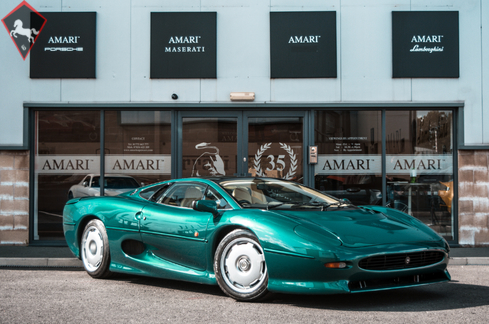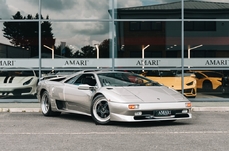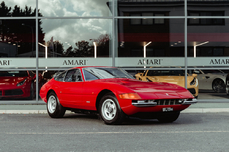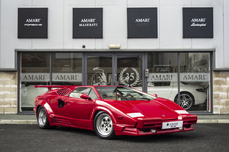Jaguar XJ220 3.5 3.5 2DR 1991
General description :
The story behind the Jaguar XJ220 is an inspiring one. Professor Jim Randall, the head of Jaguar's engineering department, started the ball rolling by sketching out some ideas whilst on a Christmas holiday in the 1980s. It was the stuff of fantasies - V12, 4WD, slippery body with ground effects. Together with colleagues in the 'Saturday Club' at Jaguar (so called because they met out of hours and at weekends to work on unofficial pet projects) they toyed with the concept until Jaguar started getting genuinely excited by the idea and official plans were put in place to build what was to be the fastest ever road car.
The Birmingham Motor Show in 1988 saw the unveiling of the powered concept with the design featuring a V12, fuel injected, 48 valve 530BHP engine delivering its output to all four wheels. Ultimately, the use of the V6 allowed the chassis to be shortened, although the proportions of this car are still truly impressive. The engine sits behind the two seat cabin, with a tiny boot available behind that. The styling is heavily influenced by the need to cool the highly tuned engine and also to provide sufficient downforce to keep the car steady at the 217mph top speed.
To say this is a very very special Jaguar is somewhat of an understatement, we are told by the vendor that chassis no 220693 was built by TWR Jaguar in Oxford in 1991 before being despatched to Brunei having being ordered by the Royal family, finished its believed by request in an Aston Martin Colour. The car covered very little mileage in intervening years and was repatriated back to the UK in September of 2002. According to records at its first MOT in the UK in July of 2002 it had a mileage reading of 1412 and as befitting a car of this nature the car then became the property of flamboyant champagne dealer before changing hands a further 3 times in the U.K, in 2006, 2014 and 2016 before being offered for sale today. `
There's no doubt about it, this car is as visual as it is all about power, it may be 20 years old, but this Jaguar still holds its own in the era of the Hypercar. Turn the ignition key, hit the starter button and behind your head the Group C derived V6 bursts aggressively into life, harsh metallic whips of sound lash wildly from the engine bay, it's a noise straight from the Le Mans pit lane. Once up to speed it becomes addictive to lift off the accelerator and listen to the frenetic mixture of turbo waste gate chatter. Continuing to feed power through the gearbox only results in more drama as it reaches the limits of its abilities before the brace of mighty turbochargers reach full compression and the seductive noise dissipates into an aeronautical gale of vast quantities of air being manipulated both around the high-downforce body and through the engine.
Make no mistake this car has the looks to match, the metallic green paintwork is absolutely stunning from any angle thanks to the fact that this particular XJ220 was the subject of a hugely expensive glass out repaint in 2007. It was also decided at the same time an internal retrim was in order; the nett result is a car that looks better than the day it left the TWR factory.
The odometer currently shows a speedo reading of just under 6000 miles and is supported by MOT certificates dating back to 2002. We are reliably informed that this particular XJ220 has had work done by probably the UKs leading authority on XJ220s namely Don Law based of Staffordshire. This included in the summer of 2015 included a full overall at considerable cost, in which, a 24 month service was carried out along with replacement of the clutch, fuel tanks and pumps. Since then the car has travelled less than 500 miles. Other than trips to the MOT station this car has had little use over recent years.
Sold with its original factory hand pack and supporting documents. Only 281 of these Jaguar icons were ever built and contrast with todays standards of automotive restraint and green manufacturing; which makes all the more sense to buy one whilst you still can.
The car has recently returned from Jaguar Land Rover Classic where it has undergone a major overhaul including a major service and new clutch, at a total cost of £16,000.
Most recent service 27th November 2020 (6,047 Miles) by Jaguar Land Rover Classic
Just recently passed an MOT, which expires on the 21st January 2021.
To make an appointment to view, please call our customer services team on 01772 663777.
Viewing strictly by appointment.
https://www.amarisupercars.com/detail/297971/jaguar-xj220-coupe-3-5-2dr
1991 Jaguar XJ220 3.5 3.5 2DR is listed sold on ClassicDigest in Preston by Amari Super Cars for Not priced.
Car Facts
Car type : Car Make : Jaguar Model : XJ220 Model Version : 3.5 3.5 2DR Engine size : 3.5 Model Year : 1991 Sub type : Coupé Location : Preston
Sold
Seller Information
Sold
People who viewed this Jaguar XJ220 also viewed similar Jaguar listed at ClassicDigest
Other cars listed for sale by this dealer
About Jaguar
Ah, the story of Jaguar, from its early days as the SS Cars Ltd. to its pinnacle with the D-type, and the street-going evolution in the form of the iconic E-type. There's something quintessentially British about this tale, and I'll narrate it as a British journalist might.In the Beginnings:
Our journey into the world of Jaguar begins in the 1930s, when a company known as SS Cars Ltd. emerged. Despite the unfortunate coincidence of their initials with the rising political tensions in Europe, they started producing stylish and performance-oriented cars. The SS 100, introduced in 1936, was a symbol of elegance and speed, setting the stage for what would become Jaguar.
The Birth of Jaguar:
As the shadows of World War II loomed, SS Cars Ltd. wisely decided to disassociate themselves from the SS initials. Thus, in 1945, they officially became Jaguar Cars Ltd., a name that would soon be synonymous with British luxury and performance.
The XK Series:
Jaguar's post-war era brought us the XK 120, a true sensation in 1948. With its sleek design and a powerful 3.4-liter inline-six engine, it became the world's fastest production car. The XK 120 was the blueprint for what lay ahead – Jaguars that blended style with speed in a uniquely British fashion.
The D-type Dominance:
Then came the D-type, a true racing legend. Introduced in 1954, it won Le Mans three times in the 1950s, showcasing Jaguar's engineering prowess. With its innovative monocoque construction and the iconic fin at the back, the D-type was the apex of Jaguar's motorsport success.
The E-type Emergence:
But the true turning point arrived in 1961 with the introduction of the E-type, often described by Enzo Ferrari as "the most beautiful car ever made." Its long bonnet, curvaceous body, and a 3.8-liter engine delivering exhilarating performance made it an instant classic. The E-type was not just a car; it was a work of art on wheels, and it could hit 150 mph on the road.
Street and Racing Success:
The E-type's beauty was matched by its capability on the track. The lightweight E-types were particularly successful in various racing events, cementing Jaguar's reputation as a force to be reckoned with in motorsport.
The Age of Refinement:
As we delve deeper into the Jaguar story, we find that the 1950s and 1960s were an age of refinement and expansion. Alongside the magnificent D-type and the E-type's iconic emergence, Jaguar introduced models that further solidified its reputation for luxury and performance.
The MK2:
In the late 1950s, Jaguar unveiled the MK2, a sports sedan that combined elegance with power. This sleek four-door saloon was a favorite of bank robbers and law enforcement alike, thanks to its exceptional speed and handling. The MK2 was a symbol of Jaguar's ability to blend sophistication with performance and had a successful racing career as well.
The XJ6:
Fast forward to 1968, and Jaguar launched a car that would define luxury saloons for decades to come – the XJ6. It was a masterpiece of engineering and design, featuring a smooth inline-six engine, independent rear suspension, and a spacious, beautifully appointed interior. The XJ6 was a symbol of British elegance and provided a ride so smooth that it seemed to glide over the road. It became the flagship model for Jaguar and set the standard for luxury saloons, showcasing a level of refinement that left competitors in awe.
The Blend of Classic and Modern:
While the MK2 and XJ6 represented the evolution of Jaguar's saloon cars, they maintained the brand's commitment to performance and luxury. These cars didn't just belong on the racetrack; they were equally at home cruising down the grand boulevards or gliding through the English countryside.
The Challenges of Change:
However, as the 1970s arrived, Jaguar, like many British automakers, faced financial challenges and changes in ownership. The British Leyland era brought both opportunities and struggles, as the brand navigated through various mergers and transitions.
Nevertheless, the legacy of the MK2 and XJ6, along with the D-type and E-type, continues to define Jaguar as a manufacturer that combines timeless elegance with a spirit of performance. These classic models, whether driven on winding roads or parked as collectors' treasures, serve as a testament to Jaguar's enduring presence in the world of automotive excellence.
The Jaguar story, from its early days as SS Cars Ltd. to the creation of automotive icons like the E-type, MK2, and XJ6, is a journey that reflects the very essence of British motoring – a blend of luxury, power, and style that continues to captivate enthusiasts and connoisseurs alike.





















